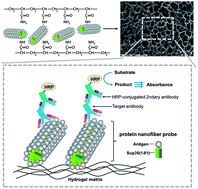A protein nanofiber hydrogel for sensitive immunoassays†
Abstract
Amyloid-like protein nanofibers were assembled in vitro using a recombinant protein fusion, with yeast Sup35 and human SSB/La proteins as assembly units, where the length of the nanofibers was mostly between 100 and 400 nm. The protein nanofibers, hereafter referred to as Sup35-based protein nanofiber probes (SuPNPs), were used to sensitively detect anti-SSB/La antibodies [Sjögren's syndrome (SS)-specific marker]. After, the SuPNPs were vinylated and subsequently linked to acrylamide. The polymerization reaction with acrylamide formed a SuPNP-hydrogel with uniform porosity, where the SuPNPs were directly cross-linked to polyacrylamide. Alternatively, biotinylated SuPNPs (bt-SuPNP) were attached to a streptavidin-hydrogel, resulting in the formation of a bt-SuPNP-hydrogel. When both the SuPNP-hydrogel and bt-SuPNP-hydrogel were used as 3D assay platforms for the detection of anti-SSB/La antibodies in a buffer solution, the LODs (limit of detection) were found to be 10 pM for both, showing 100-fold enhancement in sensitivity compared to conventional 2D polystyrene (PS) plate-based assays. It seems that the exposed surface and uniform distribution of the SuPNPs within the 3D space of the porous hydrogel matrix interacted more effectively with the anti-SSB/La antibodies, leading to more sensitive detection. The equal sensitivity demonstrated by the SuPNP- and bt-SuPNP-hydrogels above indicates that the target binding activity of the SuPNPs remains unchanged when either directly cross-linked to the hydrogel or indirectly immobilized to the hydrogel via streptavidin. When used to detect anti-SSB/La antibodies in human serum, the SuPNP-hydrogel is 1000 times more sensitive than a 2D PS plate. It seems that non-specific adsorption of the serum proteins occurs heavily on the 2D PS plate. While diagnostic assays for Sjögren's syndrome were demonstrated as proof-of-concept in this study, the SuPNP-hydrogel can be generally applied for the sensitive and specific detection of many other disease markers.


 Please wait while we load your content...
Please wait while we load your content...